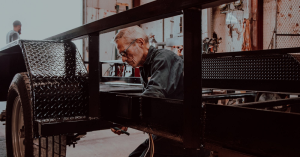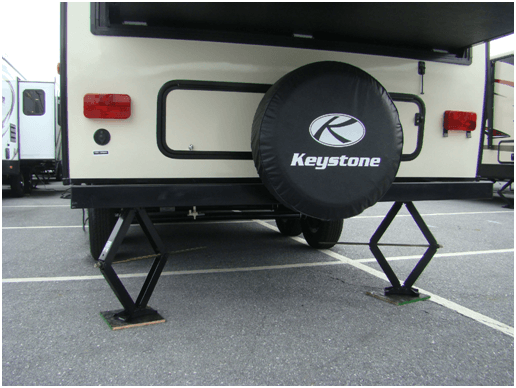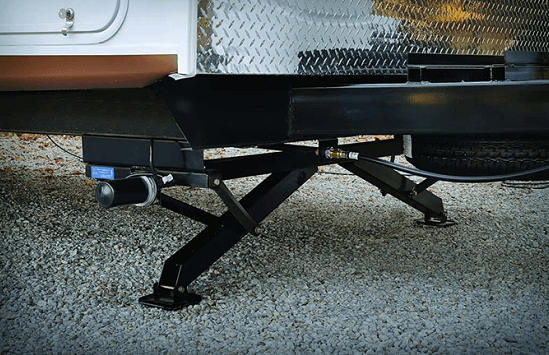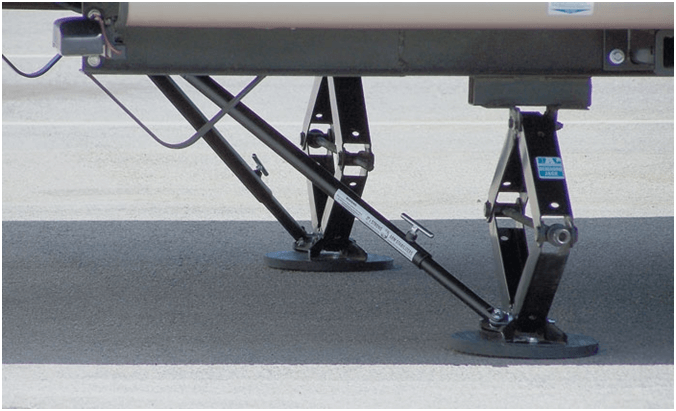
Recreational vehicles, more commonly known as RVs, are built light for convenient travel and enhanced portability. That’s exactly why they don’t work as an ideal temporary accommodation. The bigger your RV is, the more it will shake and rock, especially if it’s not on a leveled field. To solve the issue, most RVs, as well as fifth wheels, rely on a trailer stabilizer jack.
1. What is a Stabilizer Jack / Trailer Scissor Jack?
2. Difference between Leveling & Stabilizing
3. Tools Required for RV Stabilization
4. Using Stabilizer Jacks the Right Way
5. How to Eliminate Excessive Sway in Modern RVs
Scissor jacks, also known as 5th wheel stabilizer jacks, are metal arms that are installed into the vehicle’s frame and are made to extend from the RV’s body onto the ground. When you are traveling, these stabilizer jacks get retracted into the frame so they don’t cause any disruption.
On the other hand, when you park your trailer or RV, you can extend them fully until they are level with the ground.
If your RV has manual trailer stabilizing jacks, make sure they are in pristine condition. If not, you can buy a trailer jack replacement to ensure your RV remains stabilized. You can also get trailer jack parts to repair faulty ones.
If you own an RV, you should know the difference between leveling and stabilizing. Keep in mind that the trailer jacks for sale online and in brick and mortar stores are not meant to keep your RV leveled to the ground. Instead, their only purpose is to ensure the stability of the vehicle so it doesn’t move when you walk around in your RV.

If your RV isn’t leveled and stabilized properly, you will have difficulty moving inside the vehicle and may roll out of your bed at night. Your RV’s refrigerator also needs to be on a leveled surface to work efficiently. The fluids within the refrigeration system circulate because of gravity and if your fridge is not leveled, it may overheat which could lead to damage. That’s why it is important to ensure that your RV is both leveled and stabilized before you turn it into a camp.
Before your house on wheels is ready for comfortable accommodation, you need to ensure that it is properly leveled and stabilized. To do that, you will need a range of simple tools so you can get the job done. Some of the tools that you will need include the following:
It is highly recommended that you get yourself automatic levels so you don’t have to yell directions to ensure your RV or trailer is leveled. They will not only save you time but prevent frustration as well. These electronic levels can be placed on the asphalt or the ground to tell you which wheels of the RV need to be lowered or raised. Some of the levels have two pieces so you don’t have to go back and forth.
Stabilizing jack pads ensure that your RV stays stable even if you are on mushy ground. They will be a great tool to have, especially if you are camping in humid places. Jack pads will assist you in staying out of the mud effectively. Lynx levelers, on the other hand, come in handy and are also great for traction. While raising your RV onto the leveler, Lynx levelers also assist in making up the space difference (between jack and the ground) when you are attempting to stabilize the trailer.
Without placing chock blocks, don’t start any work. Make it a habit to put chock blocks between your trailer’s wheels right away even before you unhitch the tow vehicle. You don’t need an RV that starts to run on its own when you are on soft or slanted ground. By placing chock blocks, you will ensure that you don’t have to claim insurance.
Lastly, hand cranks come in different shapes and sizes and you would want to get one that fits your trailer scissor jacks without any hassle. There are a few powerful cranks available as well that will allow you to lower the jack pretty quickly but they are not particularly helpful when setting stabilizers up.
The first thing that you need to do is try to park your RV on the best available leveled ground. This will ensure that you don’t need to rely on a lot of wheel blocking. Before you unhitch your trailer or 5er, make sure you check the wheels to prevent them from rolling. Keep in mind that stabilizer jacks are for stabilizing and they cannot and should not be used for leveling. Many stabilizer jack manufacturers issue a warning to that effect.
That’s why you will need to level the RV using the right tools and equipment before you deploy the stabilizers. It’s always good to have the instruction manual with you so you know exactly what to do.

It is a smart idea to place some sort of blocking, usually wooden, on the ground before you start cranking your scissor stabilizer jacks. It doesn’t only protect asphalt from damage but also provides a better grip in many cases. If the ground under your RV is soft, the blocking will prevent the 5th wheel stabilizer jacks from digging into the earth which can destabilize the RV.
That being said, there is a thing called using too much blocking. You have to keep in mind that most travel trailer stabilizer jacks rate their weight holding strength between certain heights. It means that if scissor jacks for RV are not extended enough, they won’t be able to support the weight of the trailer and may lead to further damage to the jacks as well as your RV. You need to ensure that trailer scissor jacks are sufficiently extended so they can hold the RV or trailer in place.
Once your RV has been disconnected from the tow vehicle and is perfectly leveled with wheel chocks in place, it is time to deploy the stabilizer jacks. You can either use a handheld power drill or a hand crank to perform this job. Get cranking or drilling until you feel the trailer scissor jack is sufficiently extended and is now providing resistance. Give it one or two more rotations and you are good to go.

Remember that you should never over-crank the stabilizer jack. Also, do not attempt to use stabilizers to raise your RV for replacing a flat tire or performing other repairs. The jack’s ability to hold the weight reduces drastically when it is over-extended and it may let go at the wrong time. This may not only cause damage to the stabilizer but can result in serious injuries to the RV owner.
Before you are certain that you have done a great job, you must check whether every stabilizer is extended adequately. Make sure there are no under-extended or over-extended stabilizer jacks as they can defeat the purpose of this whole exercise. Not to mention they can also cause damage to the stabilizers as well as your RV.
When you are looking to hit the road again, removing the motorhome stabilizer jacks should be your priority. Before taking out leveling blocks or wheel chocks, retract the stabilizer jacks. Ensure that you are doing it before you adjust your hitch jack. Driving with extended stabilizer jacks is a huge no-no as it can lead to accidents that can result in personal injury.
While modern RVs have redefined living on wheels in terms of convenience and comfort, they are also much taller than the older models. This means that you need to go through an additional step to make sure your new RV is perfectly stabilized. Once you have gone through the above steps but there’s still some way, you can use locking wheel chocks to reduce the rocking.
They are specially designed for towable vehicles that have multiple axles. They can easily fit between the wheels of your RV and exert that extra pressure on each tire that can help reduce movement.
Unless if you have spent a lot of money on your motor home that features heavy-duty hydraulic systems, chances are it hasn’t come with factory-installed jacking equipment. That’s why you will need to use leveling blocks underneath the wheels to ensure proper leveling. You will need to layout the leveling blocks in the form of a ramp and stack them according to the height required by each tire. Then you can drive up onto the blocks. Make sure your parking brake is set.
Whether you have an old towable trailer or a modern RV, if you are going camping, you need to ensure that your house on the wheels is perfectly leveled and stable. Otherwise, you will have to go through a less than comfortable living experience, and your equipment in the trailer such as the fridge might not work properly. This guide clearly and comprehensively outlines all the tools and steps you need to level and stabilize your RV using trailer scissor jacks.
Now that you know how you can ensure a convenient and comfortable living experience on the wheels, it’s time you go and enjoy your camping trips!
Our trailer parts expert will answer your inquiries within 12 hours.

Tow-Max is a trusted supplier of trailer parts in China, known for its huge variety of products and one-stop services. We have been supplying customers from Australia, South America, the USA, and the Middle East. Our business partners are located in Sydney, Melbourne, Adelaide, Mexico City, Dubai, etc.
No.163-1, Shang yang Road, Dongqian Lake Industrial Zone, Ningbo, 315121, Zhejiang, China
+86-574-8786-2718
+86-574-8786-2717
sales(at)soaringtrailerparts.com
©Copyright 2020. Tow-Max. All rights reserved. Powered by MML.